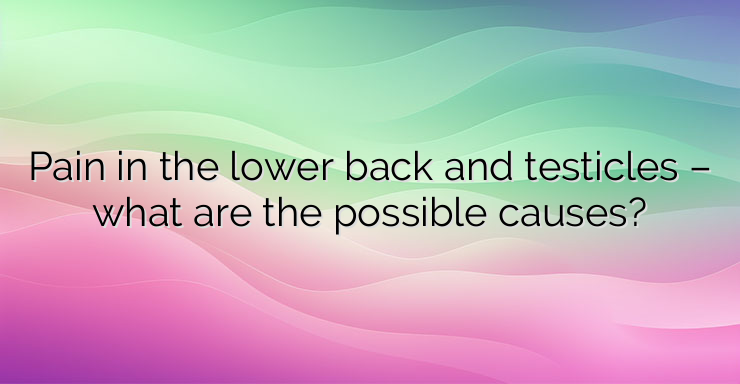Many men periodically experience lower back pain. However, lower back pain that occurs along with testicular pain is less common and may indicate an underlying condition that requires treatment. There are various reasons that can possibly cause pain in the lower back and testicles. Lumbar spondylolisthesis Injuries or birth defects can cause lumbar spondylolisthesis. Lumbar spondylolisthesis is a condition in which one of the vertebrae in the lower part of the spine, called the lumbar region, slips in relation to another. Spondylolisthesis can occur due to injuries, repetitive strain on the spine, or general wear and tear as a person ages. Lumbar spondylolisthesis can cause lower back pain if the displaced vertebra puts pressure on one of the spinal nerves. This pain can sometimes radiate to the testicles or legs. Other symptoms of the condition may include: Tingling in the back, buttocks or legs; Feeling of weakness in the legs when standing or walking; Stiffness or tenderness in the back These symptoms may improve when a person sits or bends forward. Treatment options for lumbar spondylolisthesis include physical therapy to strengthen the lower back muscles and anti-inflammatory medications to reduce pain and swelling. For people with more severe symptoms, the doctor may prescribe steroid injections. Surgical treatment may be necessary for people with lumbar spondylolisthesis that does not improve with other treatments and for people with loss of nerve function. Urinary tract infections Urinary tract infections occur when bacteria enter the excretory system, including the bladder, kidneys, ureters, and urethra. Urinary tract infections can cause pain or a burning sensation during urination, this pain can also spread to the testicles. The man may also experience constant urges to urinate. Severe pain in the lower back or abdomen, along with fever, nausea, and vomiting may indicate a serious kidney infection. People with symptoms of a urinary tract infection, especially a kidney infection, should see a doctor as soon as possible. Doctors usually prescribe antibiotics to people with a bacterial infection. It is important to follow the doctor’s instructions when the patient takes antibiotics, as well as to complete the entire course of treatment. Drinking plenty of water and urinating frequently can help speed recovery. Over-the-counter medications can also help relieve pain and discomfort. Epididymitis Epididymitis is an inflammation or infection of the epididymis (testicle), a duct that stores and transports sperm from the testicles to the vas deferens. Swelling of the epididymis can cause pain in the scrotum and testicles, which sometimes radiates to other areas of the body.including the groin and lower back. Possible causes of epididymitis include sexually transmitted infections such as chlamydia and urinary tract infections. However, there is not always a clear cause for the condition, and in some men epididymitis can be a chronic condition. Depending on the cause, a man who suffers from epididymitis may also experience symptoms that include painful urination, fever and frequent urges to urinate. Treatment for epididymitis depends on its cause. Antibiotics are usually prescribed for epididymitis caused by a bacterial infection. Resting and elevating the scrotum can help reduce swelling. Over-the-counter anti-inflammatory medications, such as ibuprofen and naproxen, can also help relieve the pain and discomfort of the condition. Bibliography: Leslie, SW, & Siref, LE Chronic testicular pain Planken, E., et al. Chronic testicular pain as a symptom of pelvic floor dysfunction American Academy of Orthopedic Surgeons (AAOS). Adult spondylolisthesis in the low back


Leave a Reply